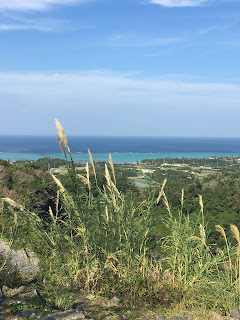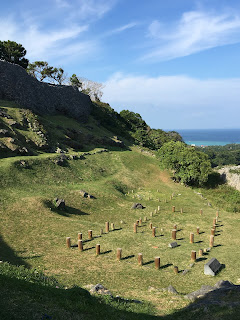Headed out with a co-worker and their spouse to check out ruins in Kunigami (near the Renaissance Hotel) and the Nakijin-jo Castle. It was a gorgeous day out; low 70s and sunny.
The ruins in Kunigami are obscure and not listed on the popular websites used by many to find activities/things to do (okinawaihai and mapitokinawa). It is listed on the road signs when driving by on the 58 near the Renaissance Hotel in Kunigami. This is a free place to visit. It is a short climb up to the top where the ruins are. This area has not been preserved; only a few markers. It had a few cave entrances, though all were blocked off. Some of the area looked like it had received blast damage, perhaps from WWII. It is right on the coast and could have easily been the site of bombings, etc. It has gorgeous views of the East China Sea.
 |
| East China Sea - from Kunigami Ruins |
 |
| Who wouldn't love to be out there on that boat right now? |
 |
Near the ruins is another area that includes burial tombs (I refuse to take pictures of these - I think it's rude)
However, this was a neat view of the vegetation |
We then headed to Nakijin-jo Castle, a World Heritage Site. It cost 400yen for an adult; this included the castle and the museum. This castle is preserved. There was a section where they were excavating to look for more history buried. Very interesting to see! Pictures are not allowed in the museum, however, there were multiple pictures that show the excavations over the years. The museum had multiple pottery, tools, jewelry, etc. that was found during the excavations. In addition, part of the museum included artifacts from the WWII era, including a complete set of Military Yen currency that was used by the locals during the war and shortly thereafter.
 |
| Dragon boat outside the museum |
 |
| How they made it - you can see the bowties |
 |
Saw this driving home and thought it was funny
The chicken and noodles in the middle of the dragon boat look very sad |
The castle is large with very thick walls. The views of the East China Sea are amazing. I really enjoy the architecture style used in the Okinawan castles; it flows with the natural surroundings. It's too bad there are no depictions of how the inside was set up when the castle was functioning.
 |
| Map of the castle and village |
 |
| Lower section - very thick walls |
 |
| Looking up at the middle section from the lower section |
 |
| A shrine (re-creation) |
 |
| Wall of middle section |
 |
On the walkway from the lower section, through the middle section, to the upper section
This was built recently and is not the original path; that is along the side and winds up |
 |
| East China Sea |
 |
| These were one each side of the gate from the lower to middle section |
 |
| View of the horse enclosure in the middle section |
 |
Looking down into the lower back section
4 small houses were back here with attached walkways between them
|
 |
| Original shrine used by the King |
 |
The lower back section...the wooden stakes show the outline of the structures
(only 2 in this picture, however, there were another 2 to the right) |
On your way out of the castle you come across a little building where a gentleman was cooking sugar cane. He was making it into a drink. It was a very condensed liquid substance that had to be diluted with water. You drink it hot. I didn't try it but my counterparts did. They said it was very sweet and thick.
 |
Largest frying pan I have ever seen
The gentleman harvests his own sugar cane and then cooks it |
At the entrance are shops and little food stalls. We stopped and got food at the "taco stall". We got a soft shell taco with a hotdog in it: tortilla shell, cheese, sauce, hamburger meat, shredded lettuce, then a full hotdog on top...you roll it and eat it. We also tried a pita bread kind of thing with curry on top...very delicious! I forgot to take pictures of the food.




















No comments:
Post a Comment